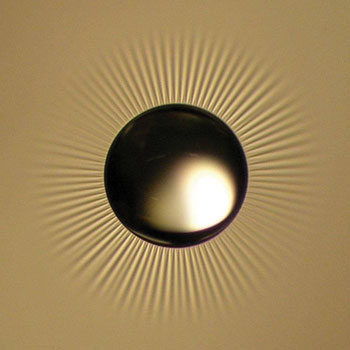
Wrinkles That Reveal Neither Wisdom Nor Angst
Scrutinizing wrinkles probably won’t tell you a person’s exact age, but as researchers from the University of Massachusetts Amherst have found, it may very accurately reflect the properties of thin films. Simple and inexpensive, their optical method allows rapid thickness and elasticity assessments.
Narayanan Menon and colleagues began their investigation by spinning molten plastic blobs into thin sheets. X-ray reflectivity analysis showed that the sheets ranged from 31 to 233 nm in thickness.

Wrinkles emanating from a drop of water placed on a raft of thin plastic sheeting can do more than dazzle the eye — they also can reveal key properties about the film in which they form. Courtesy of Jiangshui Huang, University of Massachusetts Amherst.
On top of water in a dish, they placed 1- to 2-cm-diameter circular cutouts of the film. While observing the floating cutouts under an Olympus stereomicroscope, they depressed the center of each using a tiny water droplet or a metal disk, or by poking with a needle. These perturbations produced a pattern of wrinkles radiating from the center of the film, as shown in the image. Through one eyepiece of the microscope, the scientists captured images using an Olympus digital camera.
Closely examining the photos, they counted wrinkles and determined their length for each trial. Both the number and length of wrinkles, they discovered, increased with water droplet diameter. Droplets induced the fine lines predominantly by capillary action, whereas solid objects exerted no capillary force and thus had to be heavier to produce the same effect. Metal disks and needle prodding also caused the film to stretch significantly, while water did not. Because of these effects and the ease of applying water to the surface, the researchers chose droplet-deformed samples for further analysis.
Combining wrinkle count and length with observed droplet diameter, surface tension and other values, the investigators mathematically derived the thickness and elasticity of the selected membranes. Thickness estimates closely approached those obtained with the x-ray measurements, and elasticity was near that calculated using complicated machines. A summary of the work appears in the Aug. 3 issue of Science.
The scientists note that the method could aid in the examination of thin coatings, polymeric materials and even protein layers, such as those that form on the top of heated milk. The technology also can be applied to monitor the time it takes for wrinkles to relax in substances exhibiting both liquid and elastic behavior, permitting assessment of their traits as well. In all of these settings, the system offers the advantages of wide availability and low cost.
Published: September 2007